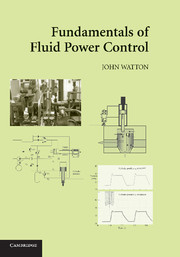7 - Some Case Studies
Published online by Cambridge University Press: 05 June 2012
Summary
Introduction
These studies represent a variety of mathematical and simulation solutions for a range of components and systems and also include much experimental testing with some novel measurement techniques and practical limitations. They are intended to bring together the various aspects of fluid power theory introduced in earlier chapters, but in a more comprehensive manner usually required for more complex systems studies involving the integration of components and control concepts.
Performance of an Axial Piston Pump Tilted Slipper with Grooves
Introduction
This study was undertaken by Bergada, Haynes, and Watton with experimental work in the author's Fluid Power Laboratory at Cardiff University as part of a comprehensive study on losses within an axial piston pump. It was concerned with a new analytical method based on the Reynolds equation of lubrication, with experimental validation, to evaluate the leakage and pressure distribution for an axial piston pump slipper, taking into account the effect of grooves.
The analytical work was developed by JM Bergada (UPC, Terrassa, Spain) with experimental work undertaken by JM Bergada and JM Haynes. Additional CFD analysis and test-rig design was undertaken by JM Haynes and J Watton. Further CFD results by R Worthing and J Watton are also presented in this overview.
The equations consider slipper spin and tilt and are extended to be used for a slipper with any number of grooves.
- Type
- Chapter
- Information
- Fundamentals of Fluid Power Control , pp. 421 - 488Publisher: Cambridge University PressPrint publication year: 2009



